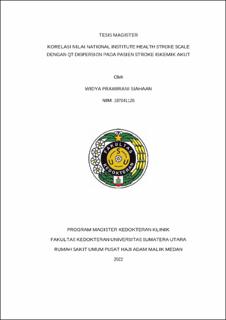Korelasi Nilai National Institute Health Stroke Scale dengan QT Dispersion pada Pasien Stroke Iskemik Akut
Relationship of The National Institute of Health Stroke Scale with QT Dispersion in Acute Ischemic Stroke Patients

Date
2022Author
Siahaan, Widya Prawirani
Advisor(s)
Arina, Cut Aria
Iqbal, Kiki Mohammad
Metadata
Show full item recordAbstract
Background
Stroke is a global health problem whose incidence is increasing every year throughout the world. Stroke can cause disorders of the autonomic system in sufferers including cardiovascular disorders. Several studies examining cardiovascular disorders after acute stroke using electrocardiography (ECG), one of which is the QT Dispersion.
Objective
This study aims to examine the relationship between the National Institute of Health Stroke Scale and the QT Dispersion.
Methods
This research is analytic correlation with cross-sectional design. The study sample
consisted of 50 acute ischemic stroke patients. QT Dispersion were assessed based on the results of the ECG examination on the first day of treatment. Stroke outcome assessment using the NIHSS score was assessed on the first day of treatment.
Results
The mean age of the 50 subjects is 57,28±12,216. The majority were male (64%), the majority were Batak (72%), 58% Subjects graduated from senior high school and the majority works as housewives 32%. The mean NIHSS value obtained was 8,74±6,599.81 and the mean QTd value was 142,40±73,250 ms. The most common infarct site in this study were basal ganglia (21%). There was a significant correlation between NIHSS scores and QTd in acute ischemic stroke patients (r= 0,668, p<0.05).
Conclusion
There was a significant relationship between NIHSS scores and QT dispersion in acute ischemic stroke patients (p<0.05).
